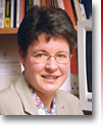|  Jocelyn
Bell Burnell Jocelyn
Bell Burnell
Dean of Science
University of Bath
Bath, England
Talk
Title: Pulsars and Extreme Physics
Abstract
Pulsars
were discovered 35 years ago. What do we know about them now,
and what have they taught us about the extremes of physics?
With an average density comparable to that of the nucleus,
magnetic fields around 108 T and speeds close to c these objects
have stretched our understanding of the behaviour of matter.
They serve as extremely accurate clocks with which to carry
out precision experiments in relativity. Created in cataclysmic
explosions, pulsars are a (stellar) form of life after death.
After half a billion revolutions most pulsars finally die,
but amazingly some are born again to yet another, even weirder,
afterlife. Pulsar research continues lively, delivering exciting,
startling and almost unbelievable results!
Biographical
Sketch
Dean
of Science at the University of Bath since 2001, I have spent
the previous ten years as Professor of Physics at the Open
University, and had a year as a Distinguished Visiting Professor
at Princeton University, USA.
I
started my academic career by failing the Northern Ireland
equivalent of the 11+. After gaining a creditable number of
O and A levels I went on to read a Physics degree at Glasgow
University, Scotland. This was followed by a PhD in Cambridge
(UK) in Radio Astronomy. During my time there I was involved
in the discovery of pulsars, opening up a new branch of astrophysics
work which was recognised by the award of a Nobel Prize to
my supervisor.
Marriage
to a peripatetic husband meant I worked subsequently at the
University of Southampton (in gamma ray astronomy) and at
University College London (in X-ray astronomy) before returning
to Scotland in the early 80's to a job in infrared astronomy
at the Royal Observatory, Edinburgh. Latterly I held a management
job there, running the James Clerk Maxwell telescope in Hawaii
as a facility for astronomers in British, Canadian and Dutch
universities. For most of this period I worked part-time while
raising a family. I have chaired, served on, or serviced more
Research Council Boards, Committees and Panels than I wish
to remember, and have also chaired a European Community Committee.
On completion of a term as Vice-president of the Royal Astronomical
Society I was elected to the Council of the Open University.
I
have used telescopes flown on high-altitude balloons, launched
on rockets and carried on satellites, and built a radio telescope
which was firmly grounded in Cambridgeshire. Later in my career
I could be found in Hawaii panting for breath at 14000' and
using the UK's infrared or millimetre waveband telescopes.
The
Oppenheimer prize, the Michelson medal, the Tinsley prize
and the Magellanic Premium have been awarded to me by learned
bodies in the US and the UK's Royal Astronomical Society has
presented me with the Herschel Medal. UK and US universities
have conferred honorary doctorates on me, and I hold an Honorary
Fellowship in New Hall, her former Cambridge College.
I
was made a CBE in 1999 and that year also won the Edinburgh
Medal for services to science and society. The Royal Society
elected me a Fellow in 2003.
The
public appreciation and understanding of science have always
been important to me, and I am much in demand as a speaker
and broadcaster. In 1995 I was awarded the Jansky Lectureship
in the USA and in 1999 toured Australia giving the Women in
Physics Lecture. I helped plan the Edinburgh International
Science Festival for a number of years, and am delighted by
its success.
My
appointment to the Open University doubled the number of female
professors of physics in the UK. I hope that my presence as
a senior woman in science will encourage more women to consider
a career in science.
In
my spare time I walk, garden, sew, swim and knit, listen to
choral music and am active in the Religious Society of Friends
(Quakers).
|